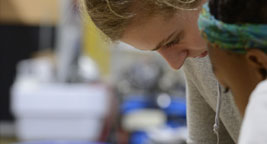One University
Tomorrow’s most pressing questions will not be confined to silos, and neither will be the solutions. From its earliest days, Johns Hopkins has embraced robust collaboration across world-class disciplines, understanding that both our intellectual curiosity and our drive to advance humanity are better served if we work together.
The university will build its future on strong and vibrant disciplines. At the same time, we will seek to remove the barriers that stand in the way of interdisciplinary scholarship and research — fostering interactions across the university that respect the discipline of the disciplines while promoting the cross-pollination of ideas that will catalyze a new generation of discovery.
The Goals
Selectively invest in programs that support our core academic mission.
Johns Hopkins became one of the world’s leading research and educational institutions by growing its programs with purposefulness, choice, and discipline. Today, we remain true to those founding principles. As our schools and divisions strategically invest in the future, they do so in a thoughtful and transparent manner, relying on objective data and sound analysis. While reality dictates that we keep costs in mind, emerging academic priorities should guide budgetary and organizational decision making, not the other way around.
Since the Ten by Twenty was introduced, our university has made new academic commitments in a range of strategic areas, many of which are detailed in the Snapshots you will find along the side. As we move forward, we must constantly ask ourselves: Have we placed a premium on faculty leadership in strategic decision making? Have we employed an inclusive approach that comprises a multitude of voices? And, have we embraced assessment and data to inform our decisions, in order to make the smartest choices about where to direct our academic resources and energies in the face of funding challenges?
Strengthen our capacity for faculty-led interdisciplinary collaboration and launch a set of innovative cross-cutting initiatives that will contribute substantially to the world of ideas and action.
At Johns Hopkins, our interdisciplinary endeavors are a source of pride. Time and again, we have achieved distinction by tackling complex challenges through cross-divisional collaboration. We champion the role of interdisciplinary cooperation as a means of solving the world’s most vexing problems. However, sometimes we get in our own way. Our structure can thwart the impulse to work together in unconventional ways, and so we must engineer more favorable conditions to encourage creative collaboration.
Since our last progress report, we’ve launched a number of cross-divisional initiatives that unleash the collaborative power of our people. Several new centers are drawing together faculty members from varied specialties. With the help of a generous gift, we are at the halfway point in our mission to hire an interdisciplinary cohort of 50 scholars working to address major world problems. And we have created a way for anyone at Hopkins to share their best ideas or vote for others’ suggestions to advance the goals of the Ten by Twenty.
Enhance the impact of Johns Hopkins Medicine, the Bloomberg School of Public Health, and the School of Nursing as the world’s pre-eminent academic health sciences enterprise by deepening collaboration among these entities and with disciplines in other parts of the university and across the globe.
At the Johns Hopkins East Baltimore campus, elite schools of nursing, medicine, and public health are all within steps of a world-class hospital, and faculty collaboration among them is part of the culture. To meet the many emergent challenges of health care and delivery in a changing world, our East Baltimore schools will need to build on that tradition, forging new collaborations among themselves and beyond.
The Snapshots you will find along the side show just two of the ways our health care experts are working together to bring lifesaving knowledge into the world, whether that means joining with a former vice president to focus on the fight against cancer or arming people with news of the most relevant medical breakthroughs. The work of building these collaborations both in East Baltimore and beyond is ongoing, but our achievements once again affirm that our many talents and resources place us in a singular position to meet the health sciences challenges of tomorrow.



